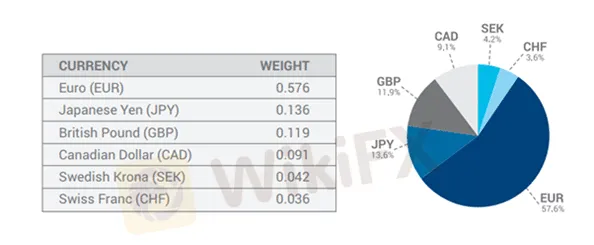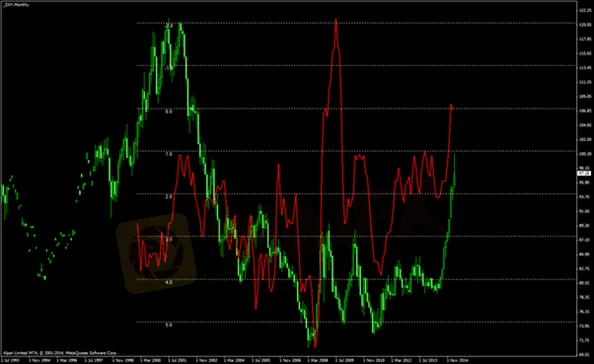简体中文
繁體中文
English
Pусский
日本語
ภาษาไทย
Tiếng Việt
Bahasa Indonesia
Español
हिन्दी
Filippiiniläinen
Français
Deutsch
Português
Türkçe
한국어
العربية
Trading USD using Consumer Price Index (CPI)
Abstract:The Foreign Exchange Market is the world’s largest trading market by volume. Trillions of dollars are exchanged each and a every day.

To be a successful forex trader, it is essential to know the factors behind demand and supply of currency. The Central Banks control the entire worlds money supply. Traders will be better prepared when they are properly able to comprehend the effect of policy decisions made by Central Banks on the currency markets.
The Central Bank of any nation has 2 major functions – One controlling inflation and other controlling fluctuation in the currency value.
Central Banks use CPI as an indicator for measuring inflation. The Consumer Price Index (CPI) is one of the most significant economic indicators that have a major influence on forex trading. The currency of a nation is directly impacted by the policy of its own central banks interest rate decisions and indirectly by the decisions of central banks from other nations.
Forex traders are advised to keep track of the CPI of most major trading nations like the US, EU, Japan, and Australia. Below section provides comprehensive information on the same.
What is CPI?
Calculation of the CPI
Types of CPI
Importance of the Consumer Price Index
Why is CPI considered as the main driver for interest rate policy?
Effect of CPI on the US Dollar Index
What is the US Dollar Index and its composition
Global Business Impact
Conclusion
What is CPI?
The Consumer Price Index is one of the most important economic indicators when determining currency value. It calculates the average change in prices of goods and services for a given period. These prices are on which the consumer buy any item from the given basket of products and services.
The CPI is usually computed monthly, quarterly or yearly but can be more often. CPI is also called as the Cost of Living Index. The CPI gives information about consumer level inflation, one of the central banks biggest concerns, and further help to provide data about the overall consumption expenditure.
When the prices of goods and services rise the economic situation turns into inflation. The CPI will then tend to increase with a rise in the price rates and further, the economy weakens. On the other hand, the lowering of CPI leads to a reduction in the overall inflation and hence strengthens the economy.
The basket of goods used to compute the CPI for most nations has more than 200 categories of items. These are divided into eight major groups, as follows:
|
|
The major uses of the Consumer Price Index are:
CPI is an essential Economic Indicator: It is used for determination of Inflation and prominently useful in the governments economic and fiscal policies.
The Deflator of other economic statistics: CPI data supports in the computation of other commercial series for deriving an inflation-free Dollar value. Examples of other economic series are Income and Wages, Retail Sales, National Income and Product Account.
Customizing of Dollar Values: The CPI assist in the calculation of Income payments, Social security payments, Retirement benefits, and Income-tax structure. The CPI prevents these economic components from any impact due to inflation. So the Labor Bureau refer this CPI and make further valid adjustment in these economic factors. Hence any inflation-induced Dollar value is avoided from hampering the benefits of financial services given to US citizens.
Calculation of the Consumer Price Index
The US Bureau of Labor Statistics, under its Department of Labor, provides the CPI for the United States. The Bureau computes the CPI for 30 days and releases this index during the middle of the month. The U.S. BLS collects data from Consumer Expenditure (CE) survey which primarily records the expenditure weights.
Consumer Price Index (CPI) for a single item is measured as follows:
CPI = (Cost of the market basket in the given year / Cost of the market basket in a Base year) x 100
Types of CPI
Urban Consumer Group: This group constitutes over 93 percent of the total urban population in the US. The Consumer Price Index for all the Urban Consumers (CPI-U), computes consumption expenditure of all urban dwellers. The people under the category of Professionals, Self-employed, Retired, Unemployed and living below the poverty line will come in the CPI-U.
Urban Wage Earners Group: The group constitutes 29 percent of the total US population. The CPI for the Urban Wage Earners and Clerical Workers (CPI-W) will compute the income of the clerical and wage earners only. The group considers only those households which earn one-third monthly income from wages or clerical jobs. The group must have at least one of the household member is employed for a minimum of 37 weeks consecutively. The CPI-W consider the cost of social security benefits of these wage group.
First, The CPI measures the cost of out-of-pocket expenditure made by the consumer. CPI records the change in prices and data about expenditure-based weights. The expenditure based weight is attached to each good or service. Therefore these weight assesses the price change impacts on the whole index.
Second, the GDP CPI index is broader. It includes prices spend by the consumer as well as the government, businesses peers and foreigners.
Third, the Personal Consumption Expenditure (PCE) is narrow in focus. The PCE index is focused only on the individual‘s consumption expenditure, unlike CPI, which measures the average household’s purchasing power.
Fourth, the CPI follows the Laspeyres formula while PCE obeys the Fisher-Ideal equation. The GDP CPI index also depends on the PCE index, unlike the CPI which is an independently calculated index.
There is an inverse relationship exists between the CPI and the Interest Rates.
The CPI does not include that portion of the population who are rural families, agricultural households, defense personnel, convicted people and mentally disabled.
Importance of the Consumer Price Index
The CPI is a crucial economic indicator for all market watchers. The index helps to provide information about consumer prices. Further, based on this index, the market can get awareness about what may happen in the Financial Market.
Why is CPI considered as the main driver for interest rate policy?
Lets take a look with the following scenarios:
When inflation is rising it means that the prices for goods and services are rising, making it more expensive for consumers to buy things. In the US, the Fed will take steps to decrease inflation by raising interest rates. Higher interest rates makes it more difficult for businesses to do business, and that slows the economy and reduces inflation.
In the case of low inflation, the prices of goods and services are cooling down. Hence the Reserve Bank will lower the core Interest Rates in order to stimulate economic activity. When the Bank gives an easy loan at lesser Interest Rates its easier to buy things and do business. When economic activity expands inflation rises.
The Central Banks tend to increase Interest Rates when there is high inflation and decrease them when there is low inflation. Therefore, when Interest Rates fall, the CPI rises, and when Interest Rates Increases, the CPI decreases.
Effect of CPI on US Dollar Index
Some proficient Forex Brokers like Tickmill provide the opportunity to trade 62 currency pairs, including majors, minors, and exotics. However, among the currencies, the major one remains the US Dollar Index.
The US Dollar Index is computed against six major rival currencies. Among them, the Euro constitutes almost half of the overall weight. When the US Dollar Index gets impacted it extends the effect onto the other related currency pairs. Theoretically, the CPI and USD Index relationship is straightforward. If the CPI goes up, then the US Dollar also soars.
If the Consumer Price Index is rising then it means costlier goods. The Federal Reserve addresses the inflation problem by boosting interest rates. Higher interest rates provide the opportunity for banks to charge more for loans, and other financial institutions to go long on US denominated assets. The overall effect translates into higher demand for USD, hence its appreciation against other currency pairs.
Lets get straight to the point. The US Dollar Index is a geometrically-averaged computation against its six major rival currencies. The index was created to maintain an external bilateral trade-weighted average value against the greenback. The rivals are the Euro, Japanese yen, British pound, Canadian dollar, Swedish krona, and Swiss franc. It may seem like only “six” countries are taken for the calculation but the actual numbers remain different.
The weight for the currencies remain in this manner:

The Euro itself contains 19 members of the European consortium of countries who follow the Euro currency. As a result, there are overall “24” countries considered for greenback formula, adding the other five rivals. Along with these 24 nations, most of the world countries closely follow the US Dollar. Hence, the greenback becomes a great indicator of its global position and the current world economic situation.
The ICE Futures US compiles and regulates the formula for the US Dollar Index.
The formula is as follows: USDX = 50.14348112 × EURUSD-0.576 × USDJPY0.136 × GBPUSD-0.119 × USDCAD0.091 × USDSEK0.042 × USDCHF0.036
The inverse correlation between the CPI and US Dollar Index
There is, of course, a direct relationship between CPI and USD from the theoretical front. However, things appear more evident in real life. The graph plotted below is of US Dollar Index and the Inverted CPI for some stipulated period.

Global Business Impact
The Global economies are integrated like never before. The US Federal Reserve is one of the strongest Central Banks in the world, its policy decisions spill over into the world economies. Strengthening or weakening in the USD has a direct and substantial impact over the world businesses.
Any increase in the interest rates provides appreciation in the dollar and that offsets all other currency. It means other currencies are now depreciated versus the USD, if their economies are weaker. This means that Import, Export and other cross border transactions of those local economies directly get affected because of fluctuation and the change in USD levels and that is what forex traders try to capitalize on – the changes in value of the currency. Hence a trader must always know the USD Index and its effect on the Global Businesses.
Conclusion
Forex Traders look forward to the CPI numbers. The most precise one is Core CPI as it excludes high volatile consumer goods but it is not the only number to watch. Under the current Federal Reserve Chair Jerome Powell, the central bank has set a target of 2.0 percent for inflation.
In conjunction with the Core CPI, traders also keep a watch on the unemployment figures over the period. Both numbers are significant from the overall economic growth perspective, therefore, considering them together is the key.

Disclaimer:
The views in this article only represent the author's personal views, and do not constitute investment advice on this platform. This platform does not guarantee the accuracy, completeness and timeliness of the information in the article, and will not be liable for any loss caused by the use of or reliance on the information in the article.
Read more

MTrading Users Report Withheld Funds and High Withdrawal Fees
Traders from Kenya and Thailand have had bad experiences with MTrading as they faced withdrawal restrictions, higher deposit fees, and refusal to release funds. Is MTrading safe to trade forex?

How the US Dollar Rules the Global Economy: Will Its Glory Continue?
The US dollar has been the world’s most important currency for many years. Its strong position, often called "dollar dominance", is not just because of America’s large economy, but for many more reasons. Keep reading to learn more!

Why High Leverage Causes Massive Losses in Forex Trading
Learn why high leverage in forex trading can lead to massive losses. Understand its risks, common mistakes, and how to manage leverage effectively for safer trading.

USD/JPY Struggles Ahead of BoJ Decision Amid Easing Trade Tensions and Mixed Data
Yen pressured by weak Japanese data and improved risk sentiment; BoJ expected to hold rates steady.
WikiFX Broker
Latest News
Love, Investment & Lies: Online Date Turned into a RM103,000 Scam
Pi Network: Scam Allegations Spark Heated Debate
Broker Comparsion: FXTM vs AvaTrade
Broker’s Promise Turns to Loss – Funds Disappear, No Compensation!
FCA Warns Public About 7 Unauthorised Financial Firms
Broker Took 10% of User's Profits – New Way to Swindle You? Beware!
Webull Canada Launches Options Trading and Advanced Tools
Account Deleted, Funds Gone: A New Broker Tactic to Beware Of?
FCA Introduces PASS and AI Testing to Support Financial Innovation
OANDA Expands ETF Offerings in EU for Portfolio Diversification
Currency Calculator


